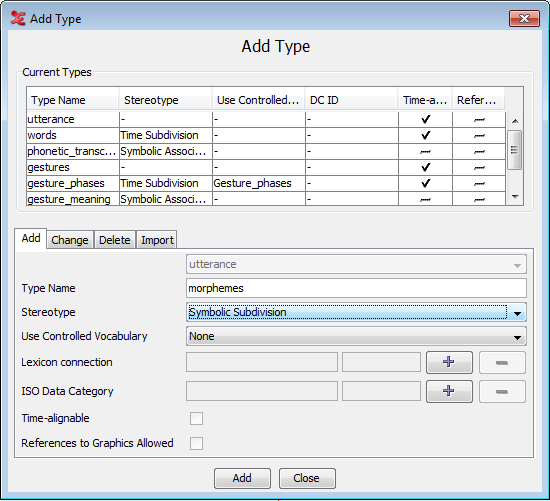A tier type consists of a number of constraints that can be applied to a tier and its annotations. Several predefined structural relations and constraints are available. A tier has to be associated with a tier type and is thus assigned to a certain type of linguistic data, for instance orthography, translation, part of speech, gesture phases etc.
To add a new tier type select from the Type menu. The window shows a table with the current types and a tab pane for adding, changing, deleting and importing type definitions.

The following attributes can be set for a tier type:
Name - should be unique in the set of types
Stereotype - None or one of four constraint types (see below)
Controlled Vocabulary - none or one of the available controlled vocabularies
ISO Data Category - the identifier of a data category in ISOcat
Time-alignable - depends on the selected Stereotype, can not be set by the user
References to Graphics Allowed - to be ignored, leave this box unticked
To modify an existing tier type, choose , >. In the drop-down box, choose what type you want to change, make the changes, and choose . Then, repeat the process with other tier types. Some changes are not allowed, as they might invalidate existing annotations on the tiers. When you are done, choose .
To delete a tier type, choose , > . In the drop-down box, choose which type you want to delete, then choose . Be careful not to do this until you first make sure that there are no defined tiers that belong to this type! When you are done, choose .
Tiers can be set up as a child tier or dependent tier of another tier. Annotations on a dependent tier each are bound to an annotation on the parent tier, the time boundaries of the child annotation cannot exceed the boundaries of the parent annotation. In other words, the child annotations are always required to be inside the interval of the parent annotation. To create a dependent tier, first make sure a tier type with a proper Stereotype has been created: “None“ is exclusively for tiers without a parent, the other types are only for depending tiers. In the Add Tier window, first select the parent tier for the new tier and then select one of the available valid tier types. The Stereotype of the tier type determines the kind of annotation that can be created on the tier. As long no parent tier has been selected only the tier types with Stereotype “None” are listed. A few additional constraints apply when setting up tiers:
A tier of a “symbolic“ Stereotype (Symbolic Subdivision, Symbolic Association) can not have a child tier of a time-alignable type (Time Subdivision, Included In).
Once a tier has been created and contains annotations, it is not possible anymore to change its tier type to a type with another stereotype.
The following table list the four currently available stereotypes and their main features:
Table 3.1. tier type stereotypes
| The annotation on the tier is linked directly to the time axis, i.e., the annotation is entered on an independent tier. Two annotations cannot overlap. |
|
The annotation on the parent tier can be sub-divided into smaller units, which, in turn, can be linked to time intervals. Note that there are no time gaps allowed, i.e., the smaller units have to immediately follow each other. E.g., an utterance transcribed on a parent tier can be sub-divided into words – each of which is then linked to its corresponding time interval. Annotations on such tiers are time-alignable. They differ from annotations on independent tiers in that they are assigned to an interval that is contained within the interval of their parent annotation. |
|
Similar to Time Subdivision, except that the smaller units cannot be linked to a time interval. E.g., a word on a parent tier can be sub-divided into individual morphemes (which are not linked to a time interval). |
|
All annotations fall within the borders of the parent tier. However, there can be gaps between the child annotations. E.g., a sentence with a silence can be split up into words while the silence corresponds to a gap in the child annotations (i.e. the separate words). |
|
The annotation on the parent tier cannot be sub-divided further, i.e., there is a one-to-one correspondence between the parent annotation and its referring annotation. E.g., one sentence on a parent tier has exactly one free translation. Or one word has exactly one gloss. |